
| Darin McQuoid | Blog | Reviews | Tutorials | River Directory |
Patterson Bend of the San Joaquin
IV-V
The Patterson Bend section of the San
Joaquin is simply a strange section of river. On the longest river in
California, Patterson Bend is an 9.5 mile section sandwiched between
Kerckhoff and Millerton lakes, in the middle of what may be the states
largest hydroelectric system. Flows are wildly unpredictable, often
only flowing during big spill events or hydroelectric maintenance with
levels varying by 1,500cfs in a 30 minute period.
Our trip was unusual due to typical San Joaquin shenanigans; on Friday night the water turned off. Then it was back on Saturday morning, but we were too late to do the whole run. It's possible to just run the bottom 1.75 mile, so the team decides to go and do just this final section of the river on Saturday, followed by the whole thing on Sunday. As I like to tell the rivers story from top to bottom, this write up is out of sequence in time, following our journey from put-in to take out.
Of all the logistics, shuttle is rather simple. We take out just above the Kerckhoff #2 powerhouse at a BLM parking lot. There is a quarter mile trail leading to the river, this trail drops about 300'.
Sunset at the River Access Parking Area.Our trip was unusual due to typical San Joaquin shenanigans; on Friday night the water turned off. Then it was back on Saturday morning, but we were too late to do the whole run. It's possible to just run the bottom 1.75 mile, so the team decides to go and do just this final section of the river on Saturday, followed by the whole thing on Sunday. As I like to tell the rivers story from top to bottom, this write up is out of sequence in time, following our journey from put-in to take out.
Of all the logistics, shuttle is rather simple. We take out just above the Kerckhoff #2 powerhouse at a BLM parking lot. There is a quarter mile trail leading to the river, this trail drops about 300'.
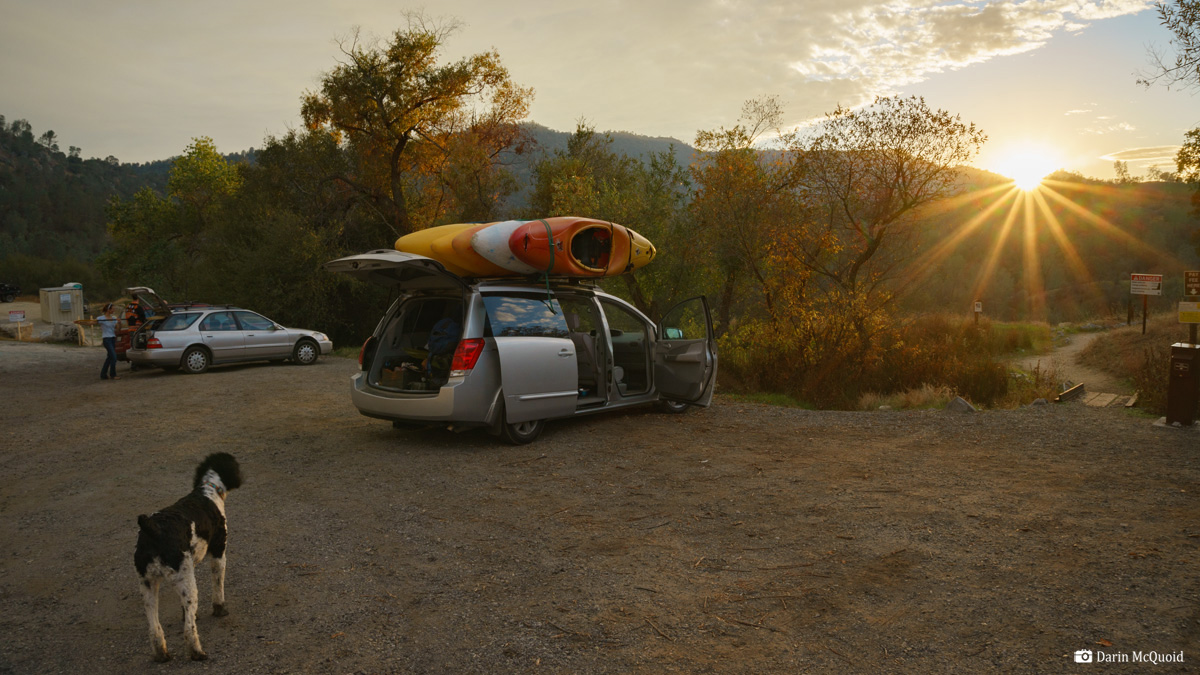
Kerckhoff Lake is lower than normal,
which gives us a nice current almost all the 1.8 miles to the dam. With
the lake so low, the PG&E repair crew has to by flow in by
helicopter; this dam is typically accessed via boat.
Haven Livingston beings the walk around Kerckhoff Dam.
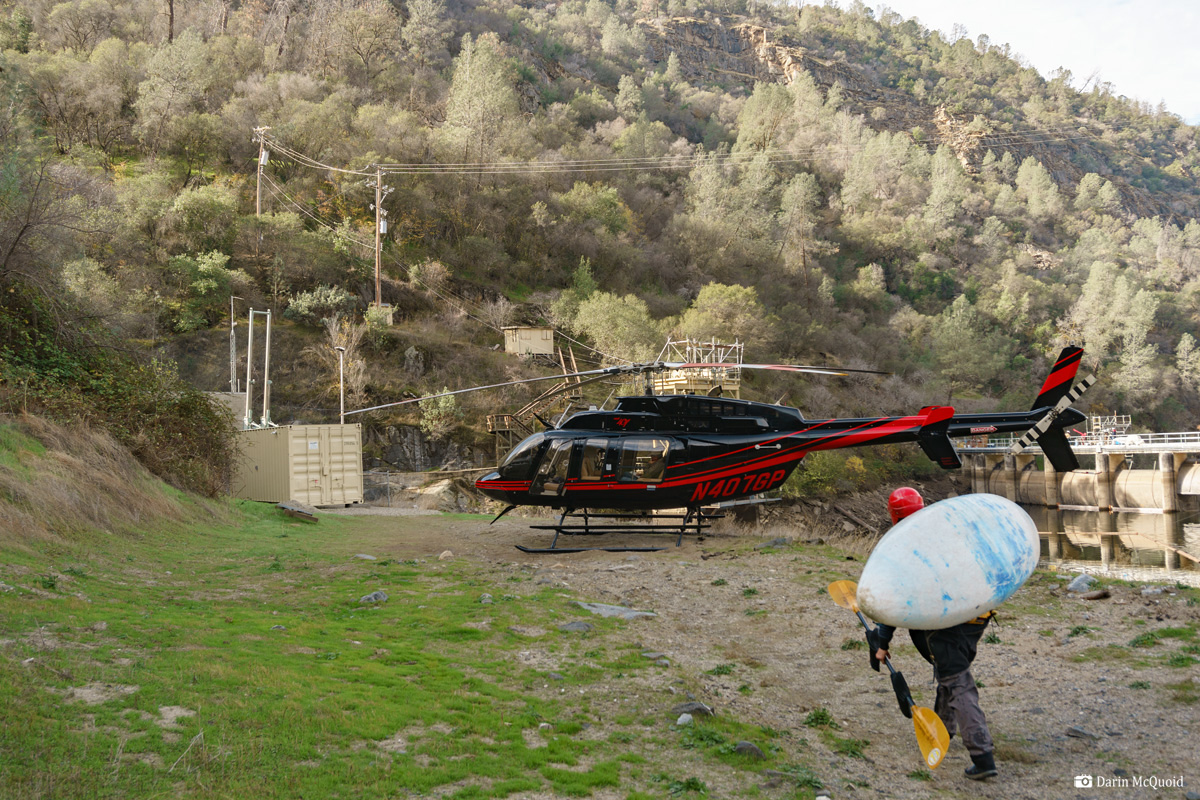
A nice ladder system allows for relatively easy access below the dam. Shannamar Dewey takes a look downstream.
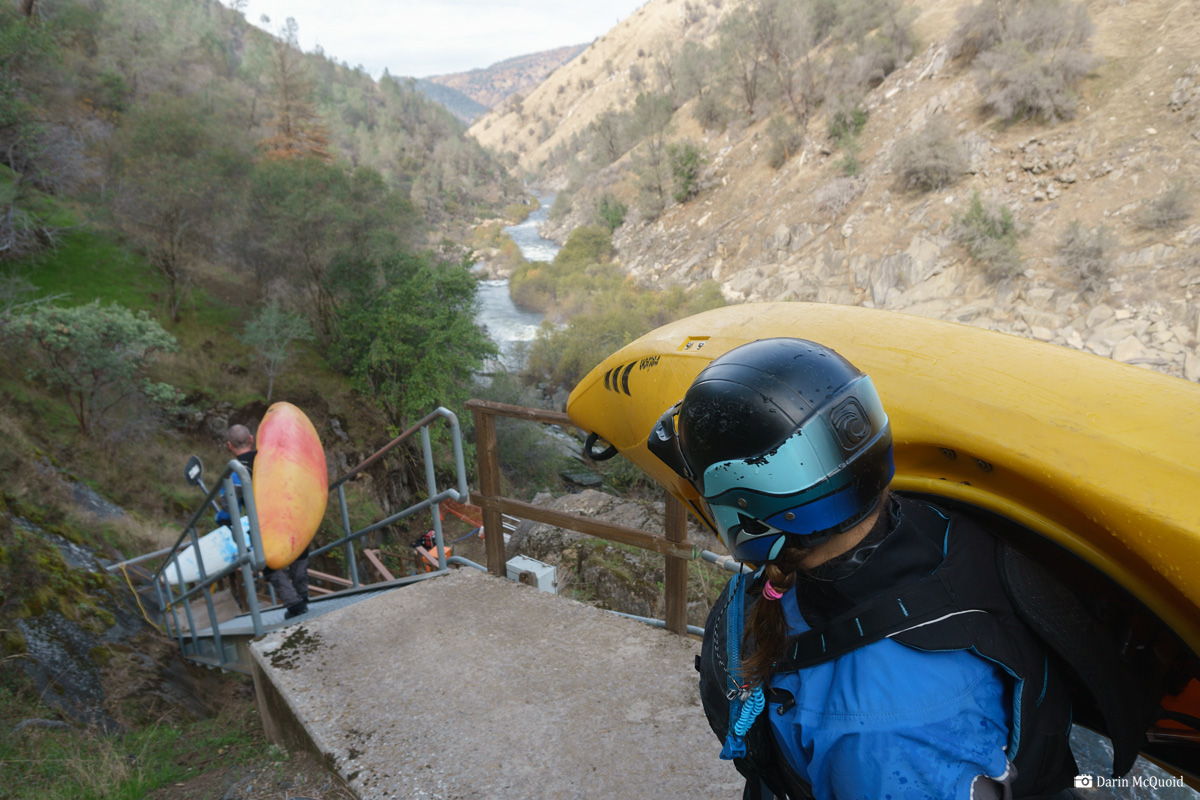
The downstream view into a nice canyon.
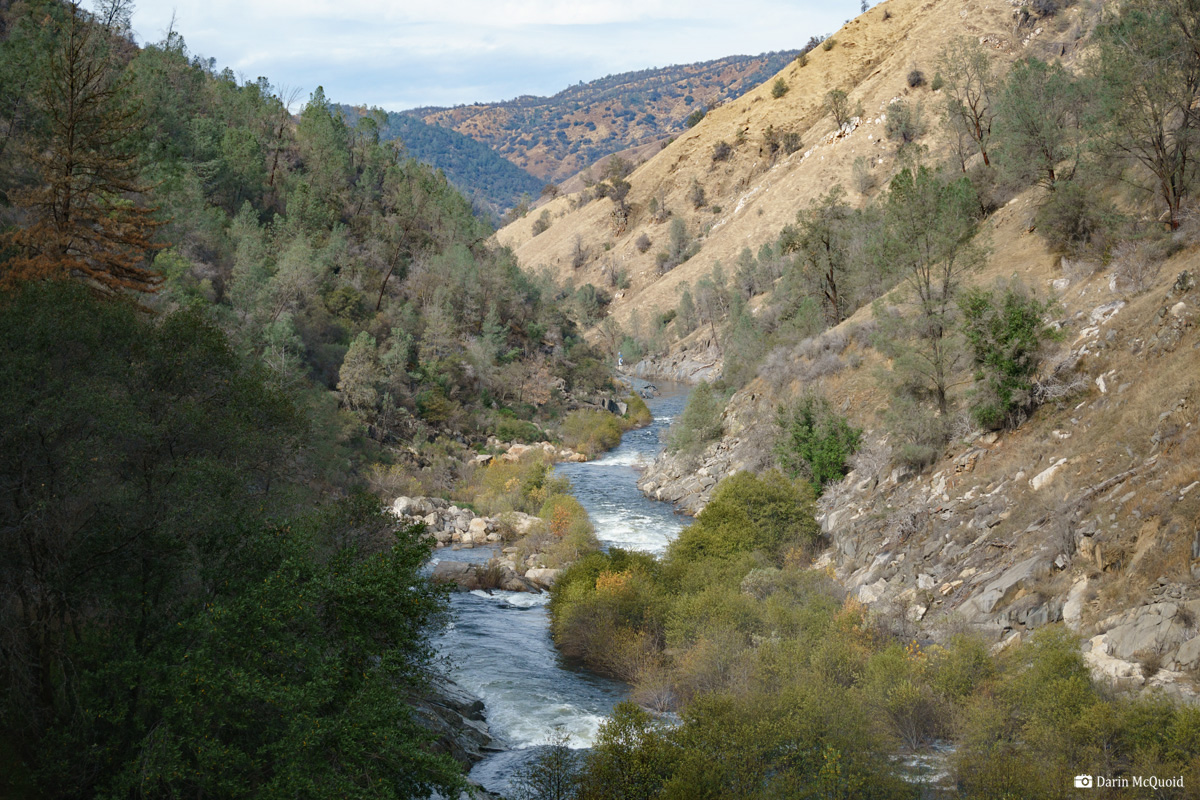
All the water in the river is coming over the spillway.
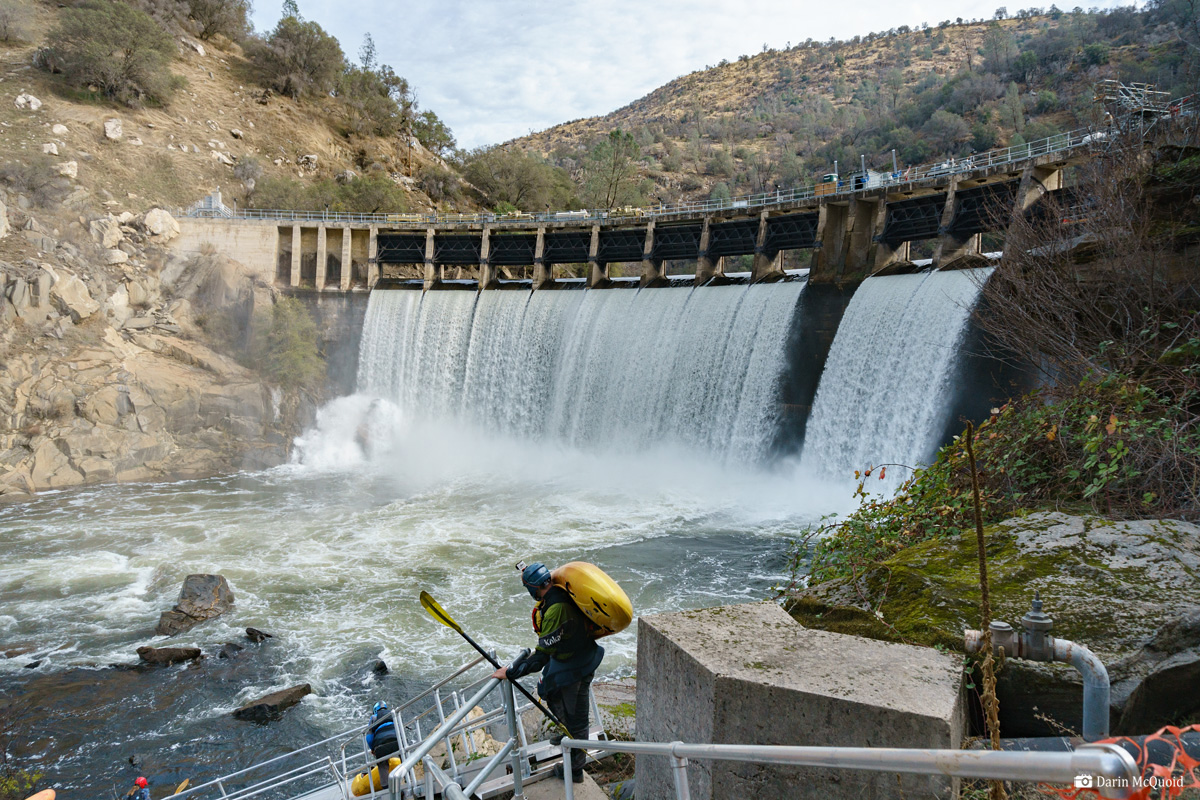
From what we'd read, there were expectations for a lot of III and some IV in the first half of the run. "The first half of the run contains many long class 2, 3 and 4ish rapids".
The first half actually contains a handful of of rapids. When they
appear, they are very high quality, but it can be a mile between rapids.
About 5.8 miles pass the dam, we encounter the first class IV rapid (in the background). Daniel Brasuell enters the first rapid that seems to what's referred to as "a particularly ugly rapid" in the AW writeup.
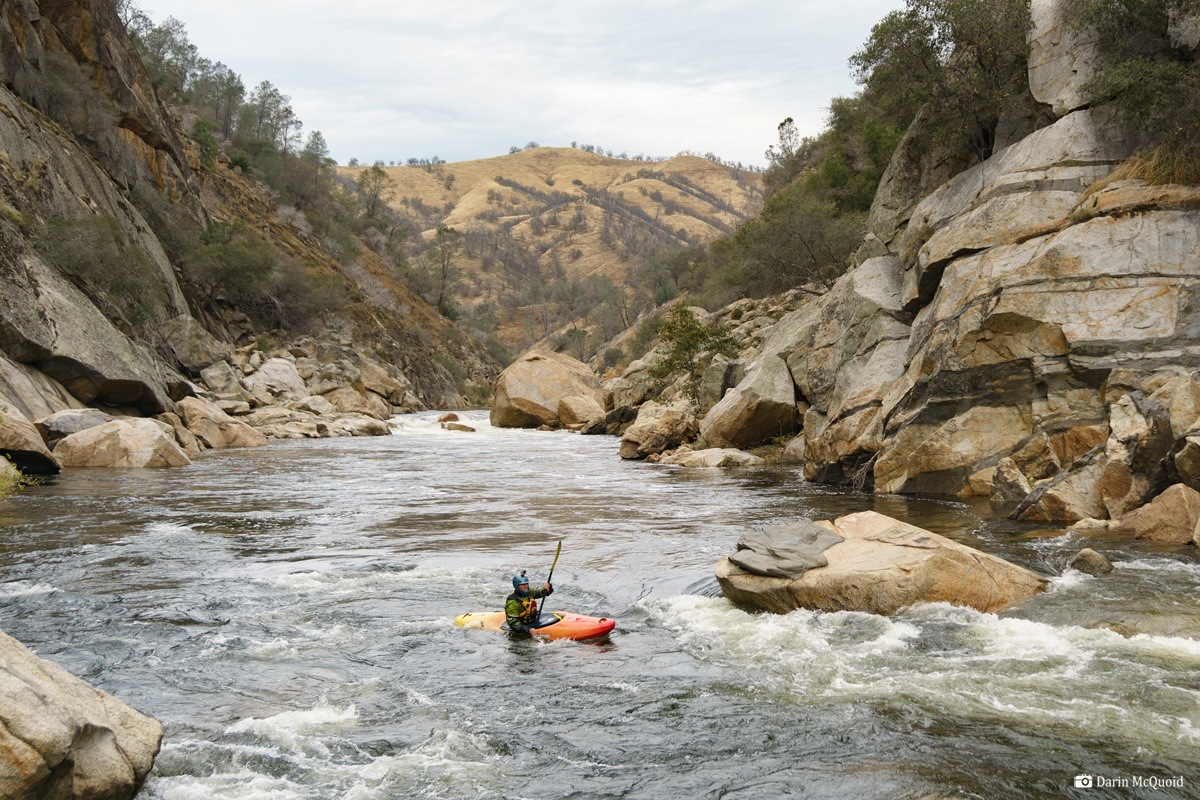
Daniel Brasuell, driving left to boof around a hole.
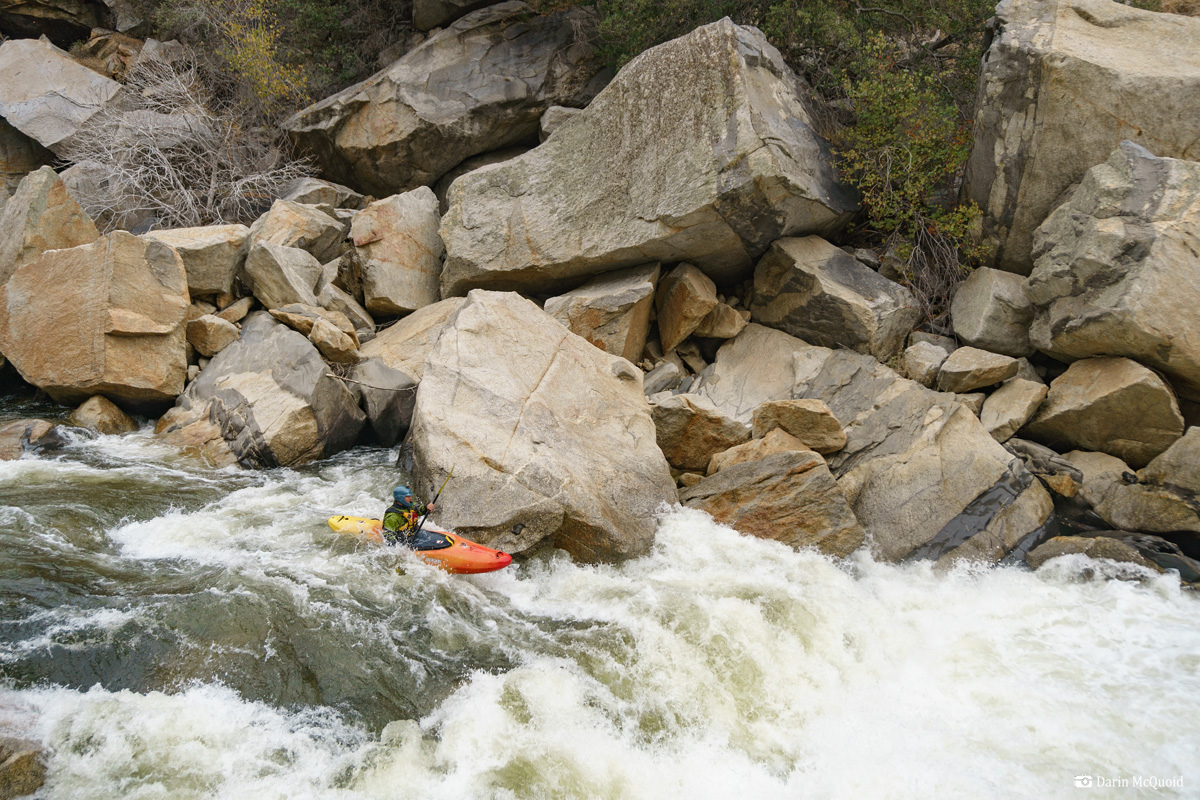
It's key to get left around this hole, it looks sticky and feeds into a siphon pile on river right. Shannamar Dewey gets left.
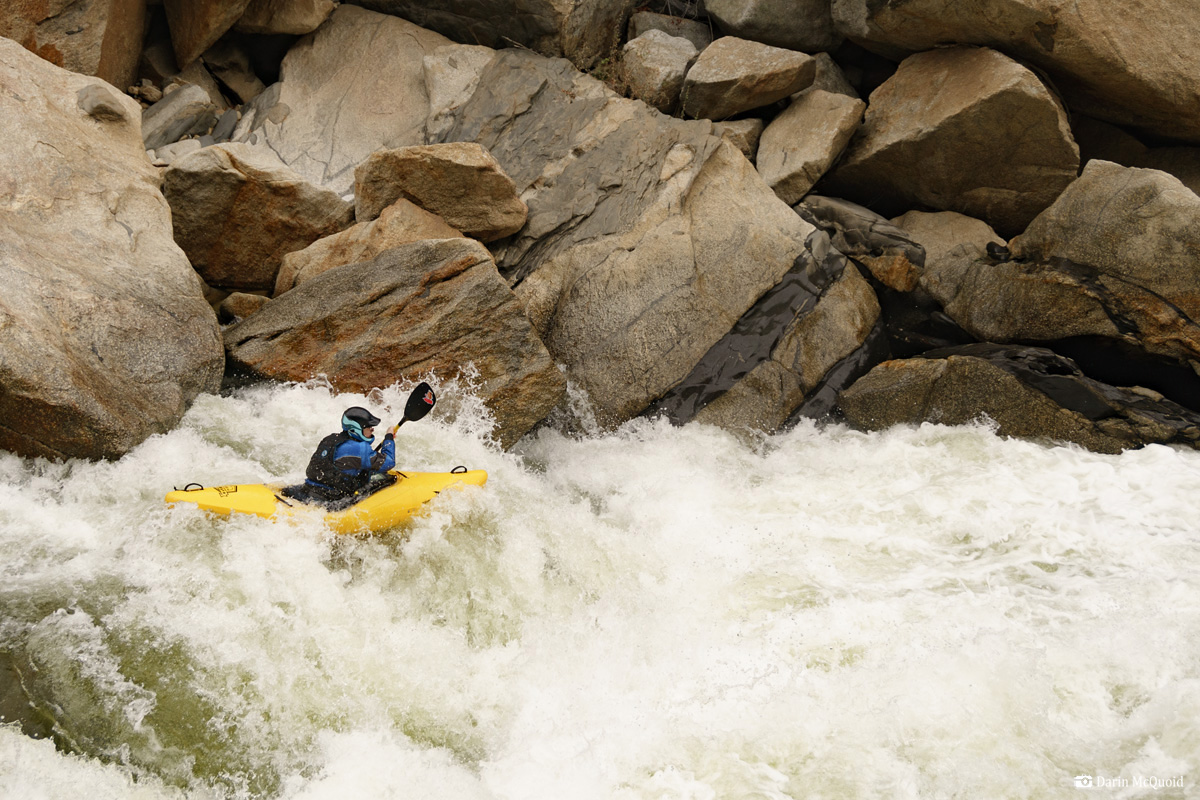
In the foreground you can see the pile of rocks that a lot of water flows under. Jeff Wheeler lines up for the final hole.
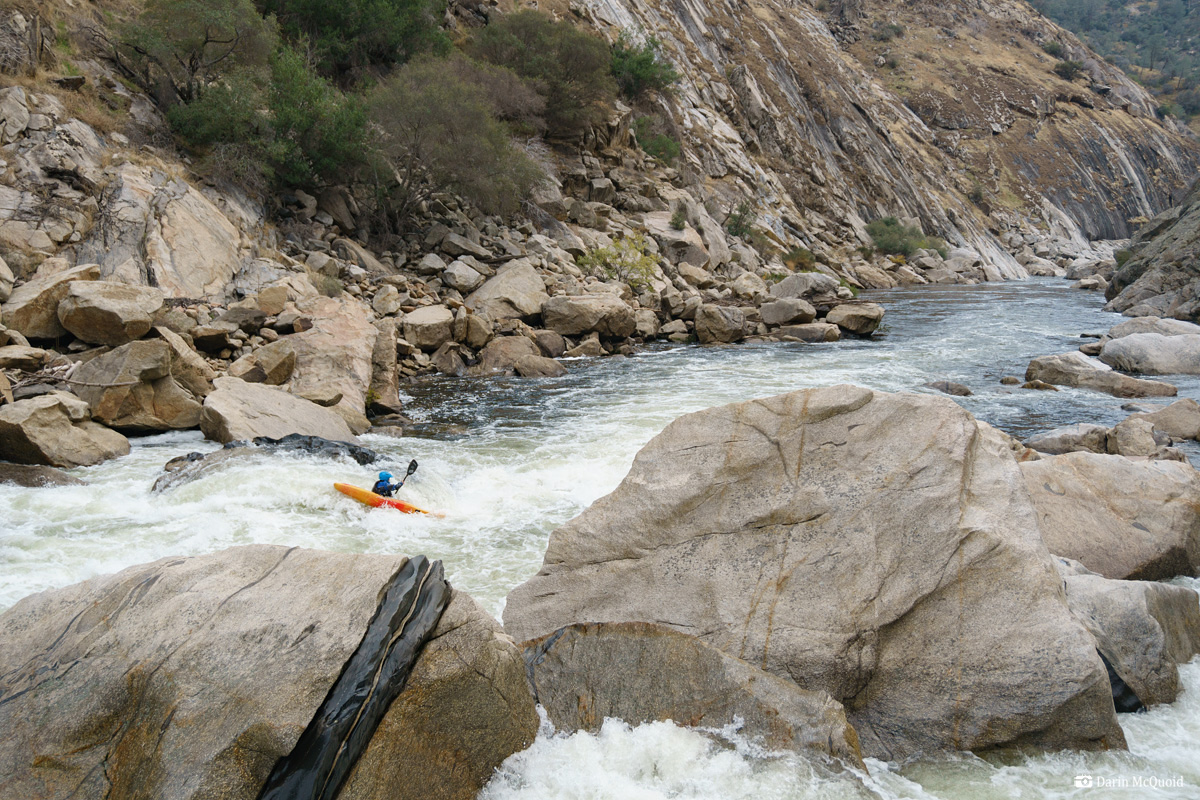
Shannamar Dewey making the final move.
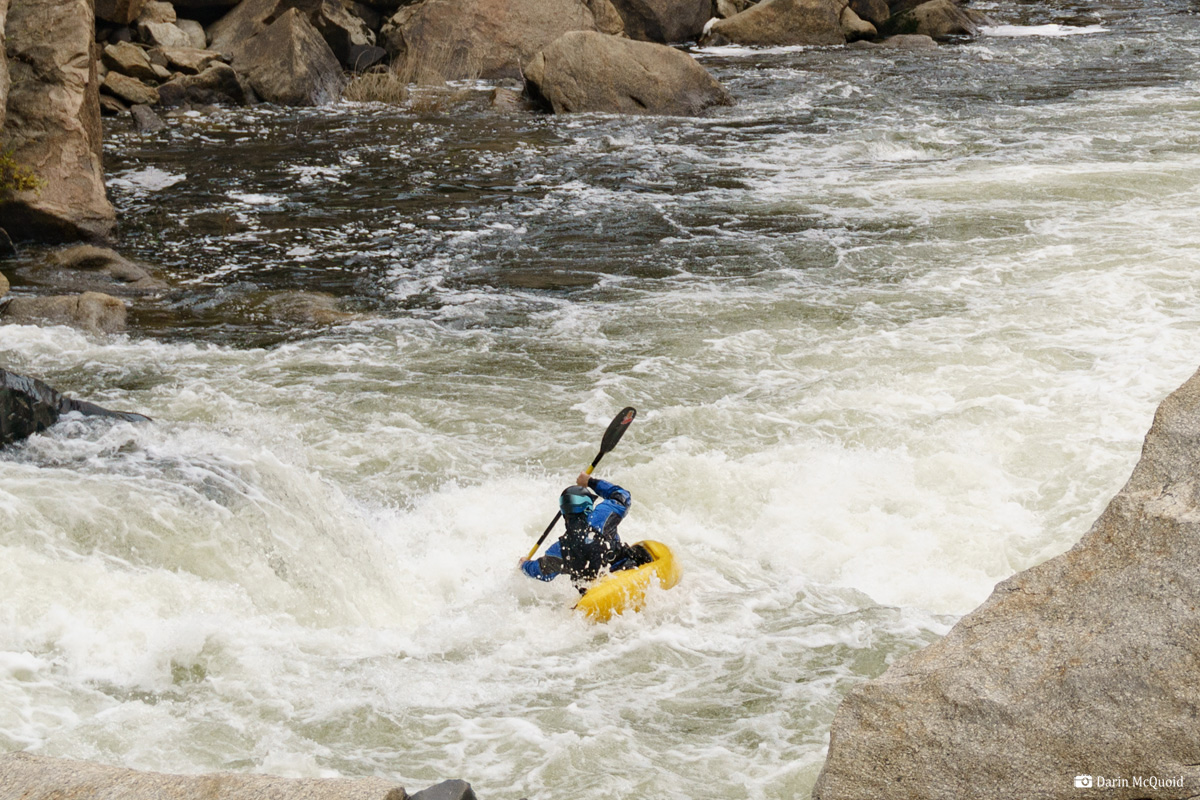
Looking back upstream at the same rapid. Classic San Joaquin boulders of immense size and sieve creating properties.
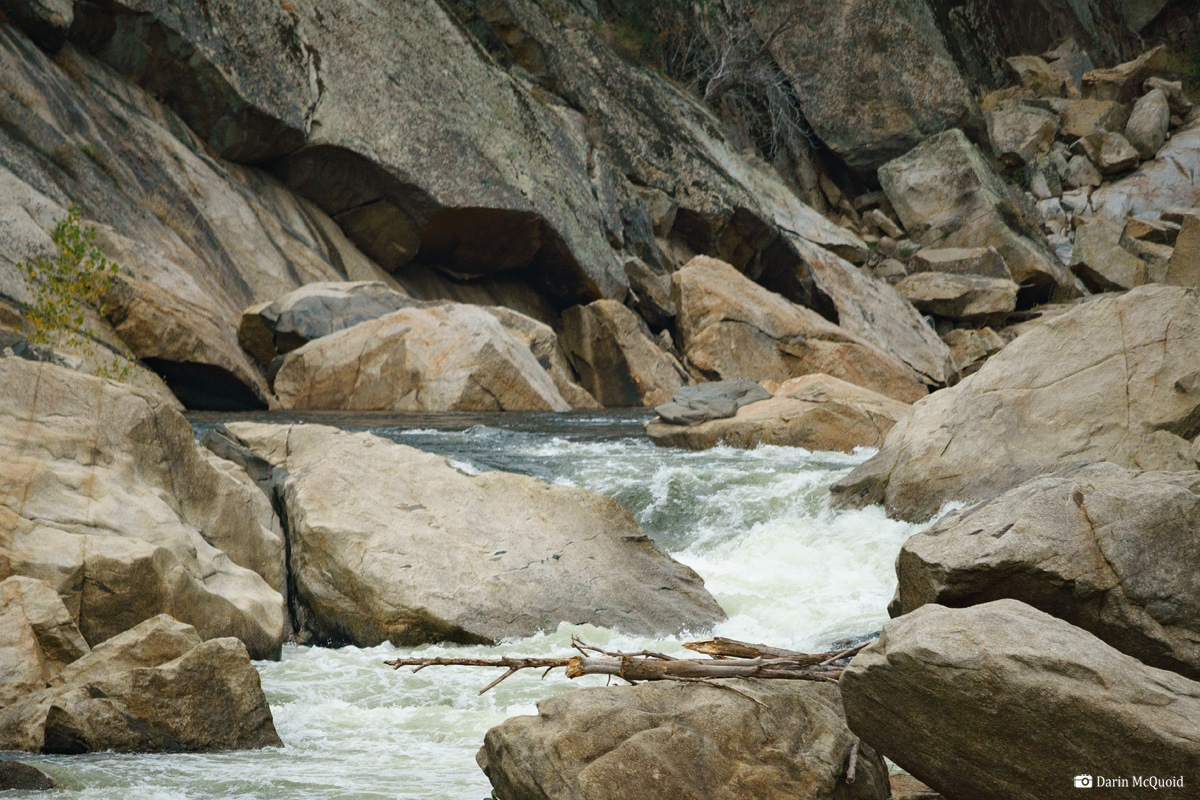
We're on our toes and out to scout the next rapid, yet no need, it's a strangely clean boof with no consequence. Haven Livingston. Nice fall colors - in the water - a classic example of a river that rarely gets water.
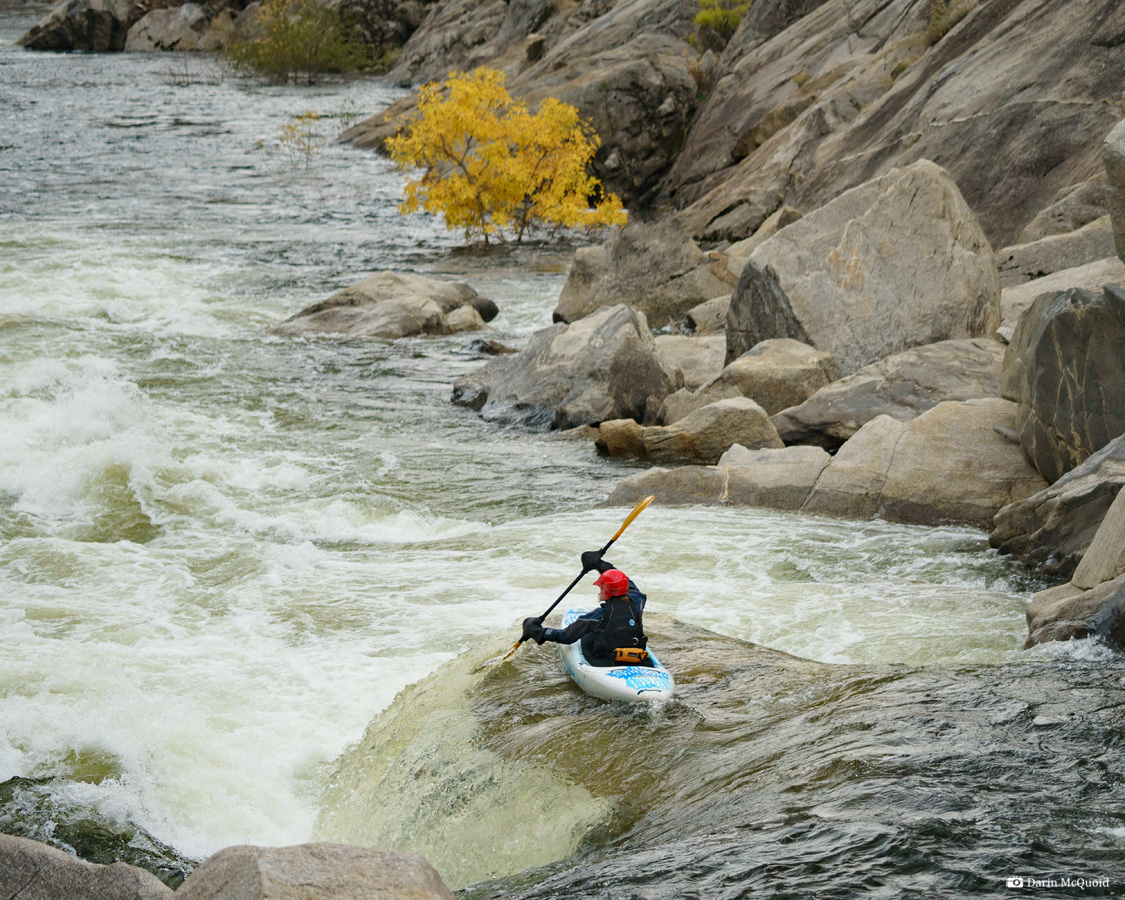
Daniel Brausell, aka Daniel "Hand of God" aka Daniel "The Human Landslide" lines up the same boof.
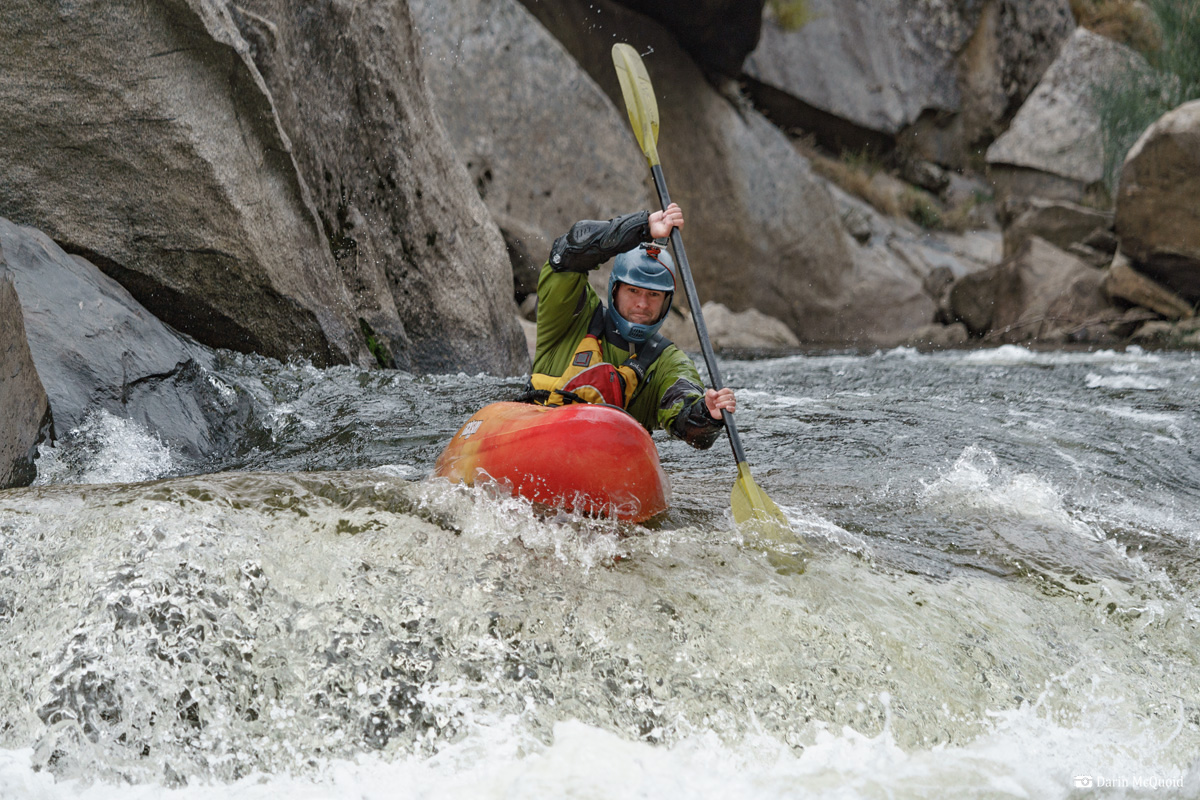
"Binocular" is everything that it's hyped to be. A huge pile of rocks on the left makes portaging unappealing. The center hole also looks unappealing. We decide the portage looks worse. Shannamar Dewey ponders.
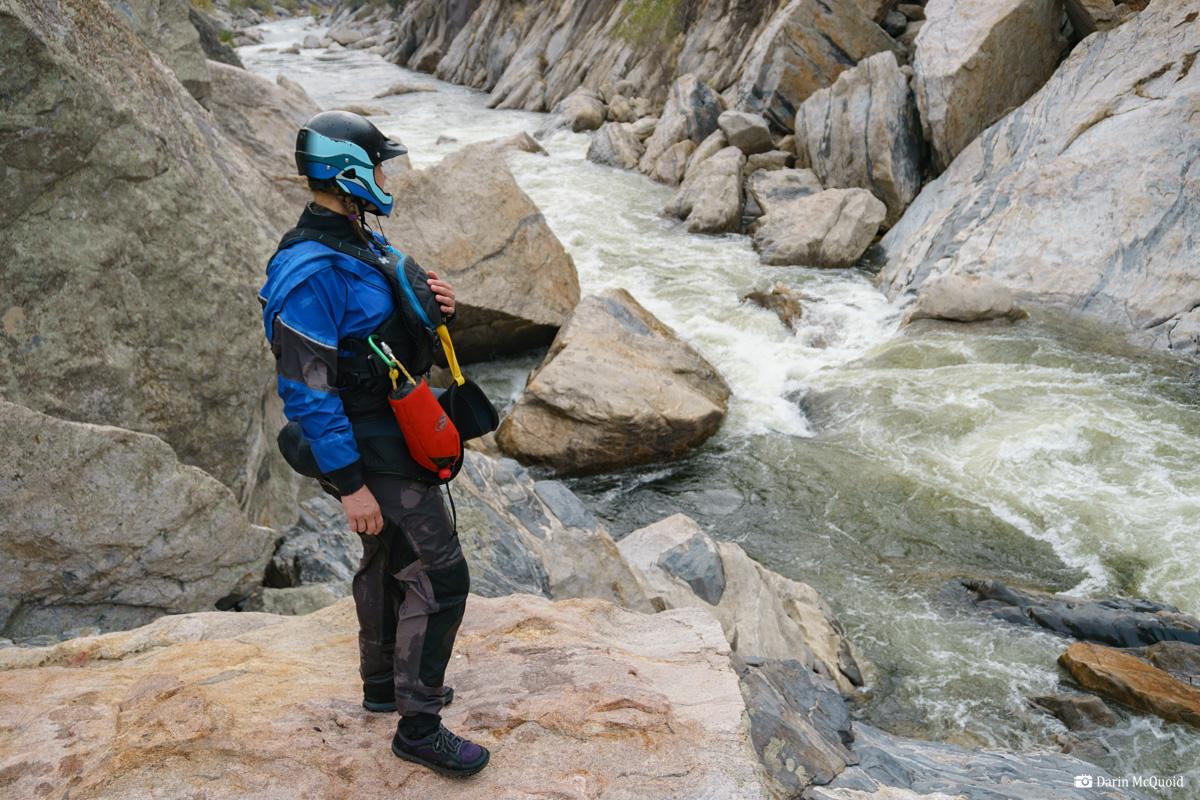
Daniel Brausell doing his best to match the fall colors.
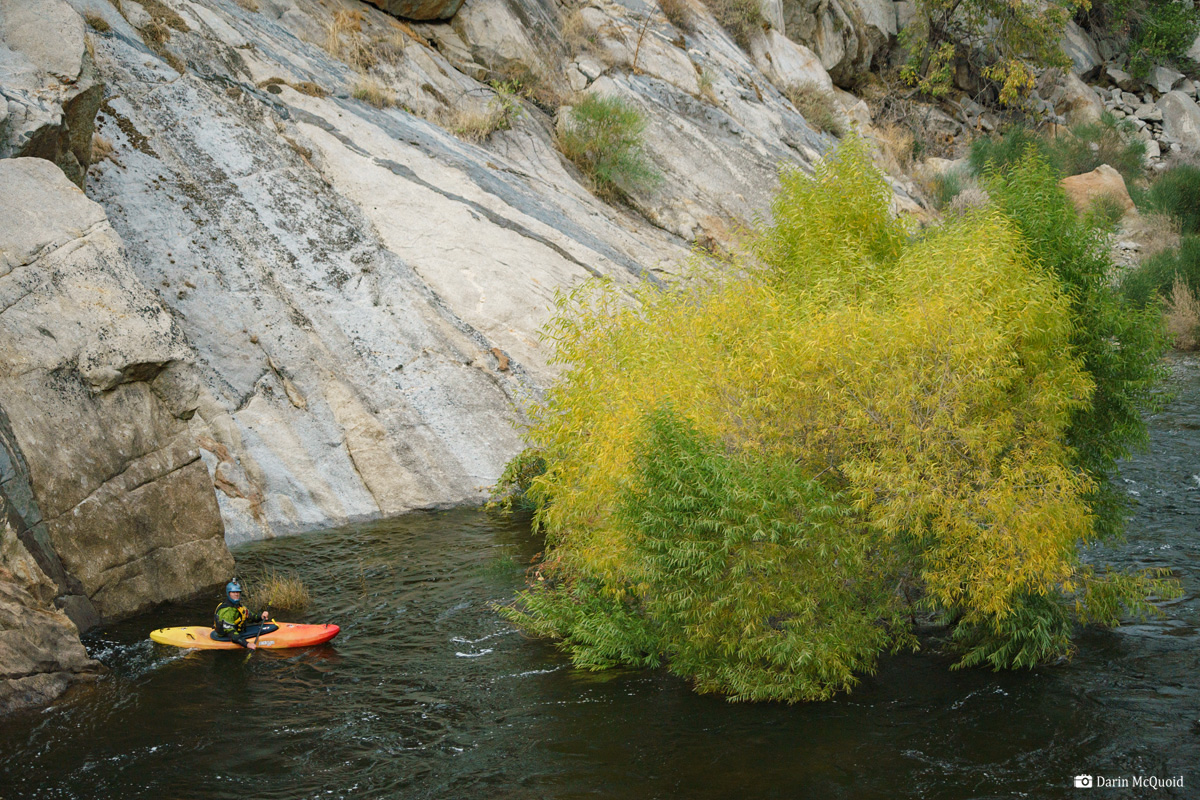
We all underestimated the first move. It looks like a nice wave, yet the river actually drops a few feet into a pretty good hole. Jeff Wheeler.
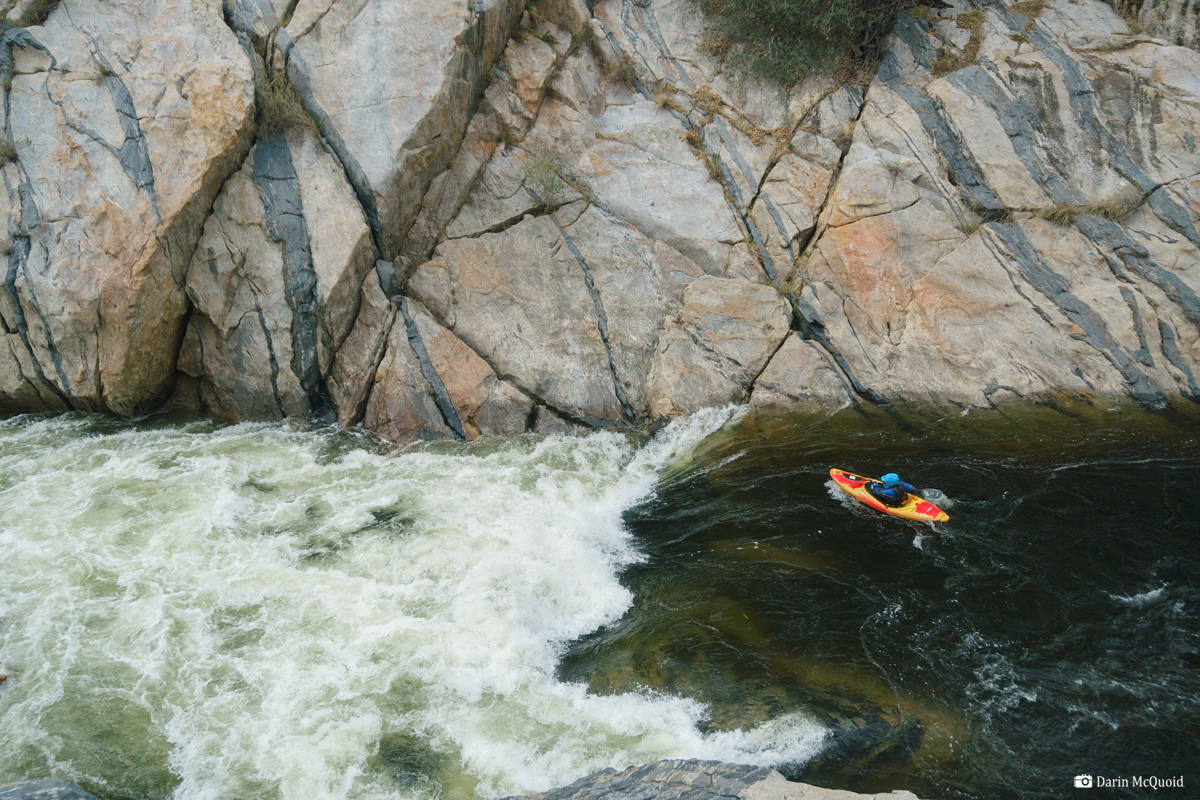
Daniel Brasuell strokes into the main move.
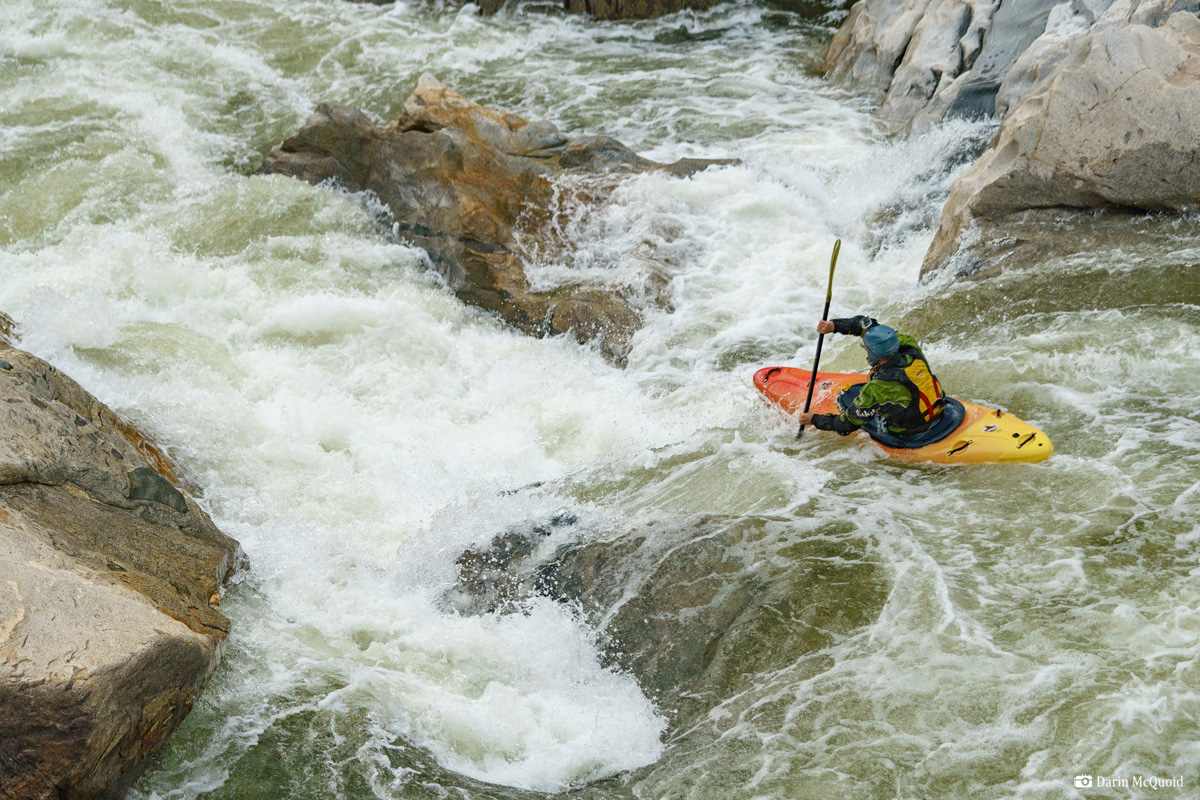
Remember kids, tips up! Jeff Wheeler comes through the main move of binocular.
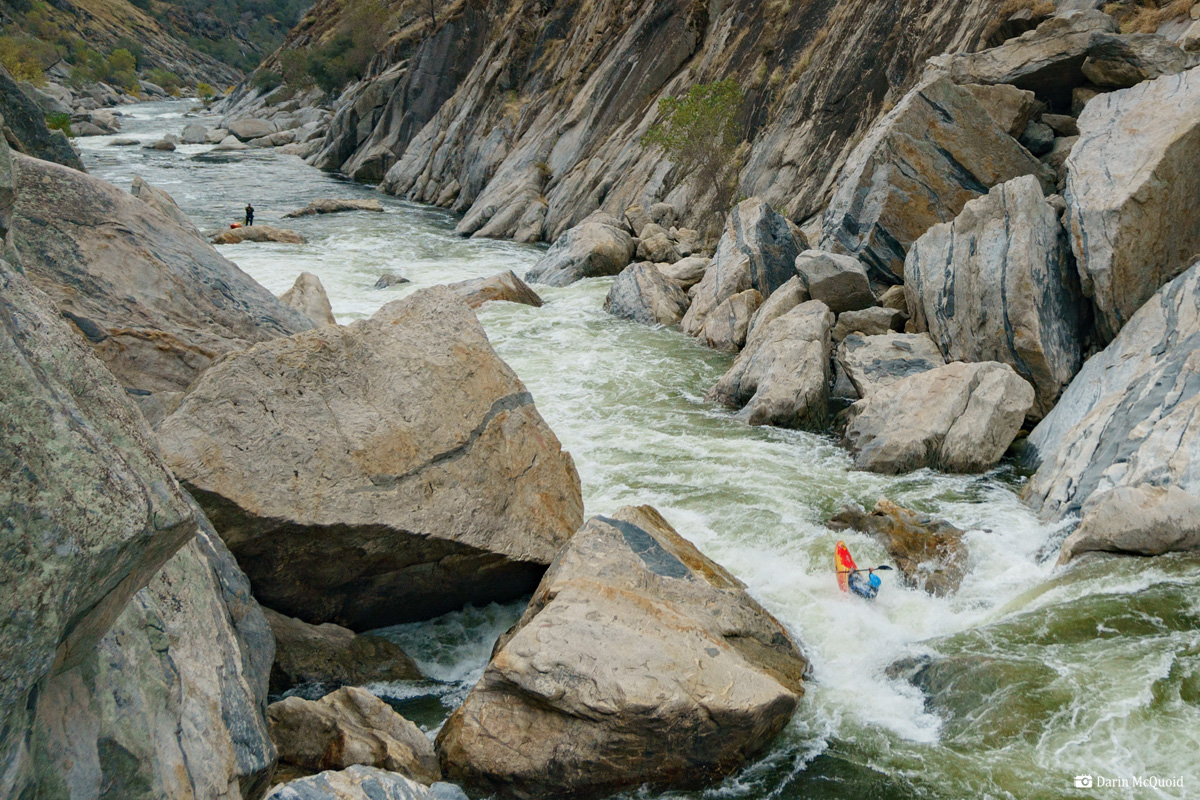
About
those flows. On the San Joaquin you never know what you'll get. We put
on with a steady flow of 2,000cfs. As I come through the bottom move of
binocular, two of the team are out taking photos, yet I see a boat
floating off downstream. I sprint after it but can't manage to get it
out before the next rapid where it goes into a cliffed out sieve.
Not terribly wedged in there, yet not easy to get out. As we know the
water was turning off in three days, we decide that the safest thing to
do is leave it until then. We all wonder how he was so careless as to
leave his kayak in a position that it could float off.
We continue downstream and the water seems to be a bit higher than yesterday. As it's afternoon now, we're getting tired and take a break for food and water. While on shore for ten minutes the river rises at least six inches. Or are we just seeing things? The second we paddled into the next rapid it's obvious that flows have spiked, and getting out turns to be a bit of a survival experience for the group. Flows have come up 1,000cfs in thirty minutes, that's why the once on shore kayak floated away earlier. Now it all makes sense.
We continue downstream and the water seems to be a bit higher than yesterday. As it's afternoon now, we're getting tired and take a break for food and water. While on shore for ten minutes the river rises at least six inches. Or are we just seeing things? The second we paddled into the next rapid it's obvious that flows have spiked, and getting out turns to be a bit of a survival experience for the group. Flows have come up 1,000cfs in thirty minutes, that's why the once on shore kayak floated away earlier. Now it all makes sense.
Our
first day we park just above the old Kerckhoff #1 Powerhouse and do
some cross country scrambling to get to the water. Footing is very
loose.
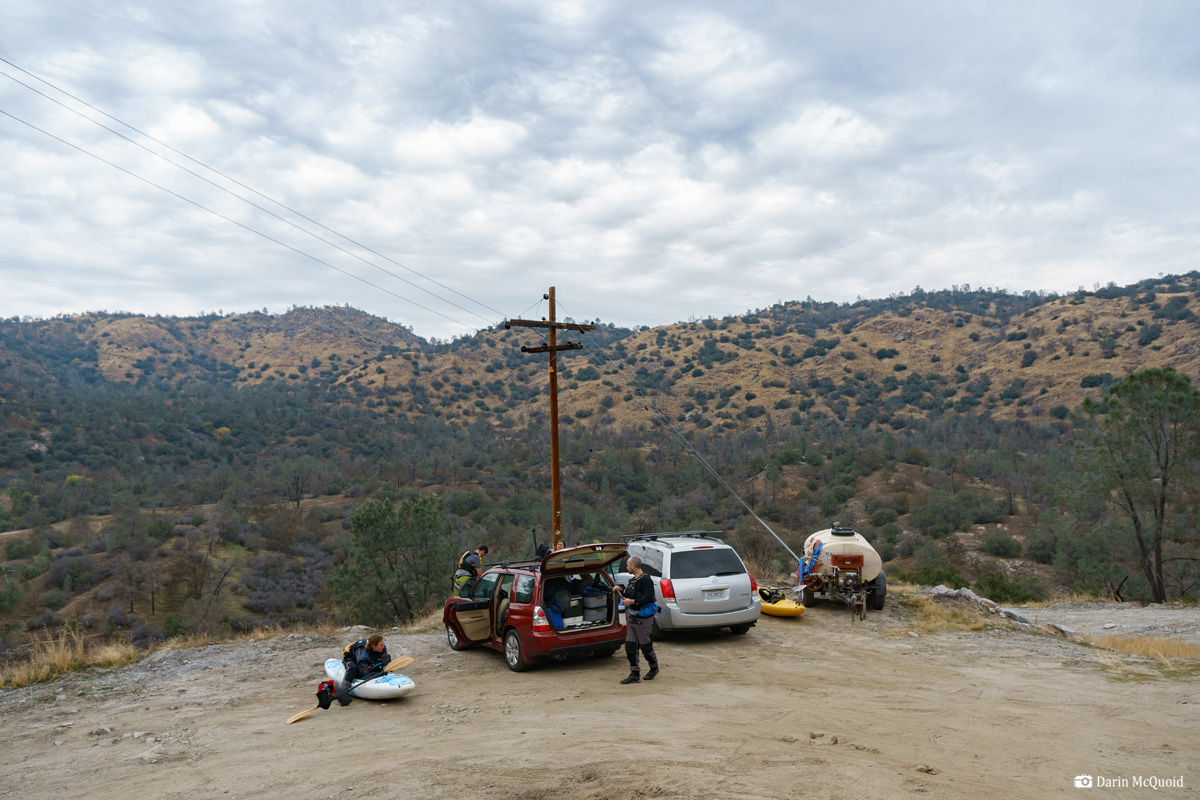
At the river just above the powerhouse.

Shannamar Dewey paddles past Kerckhoff #1.
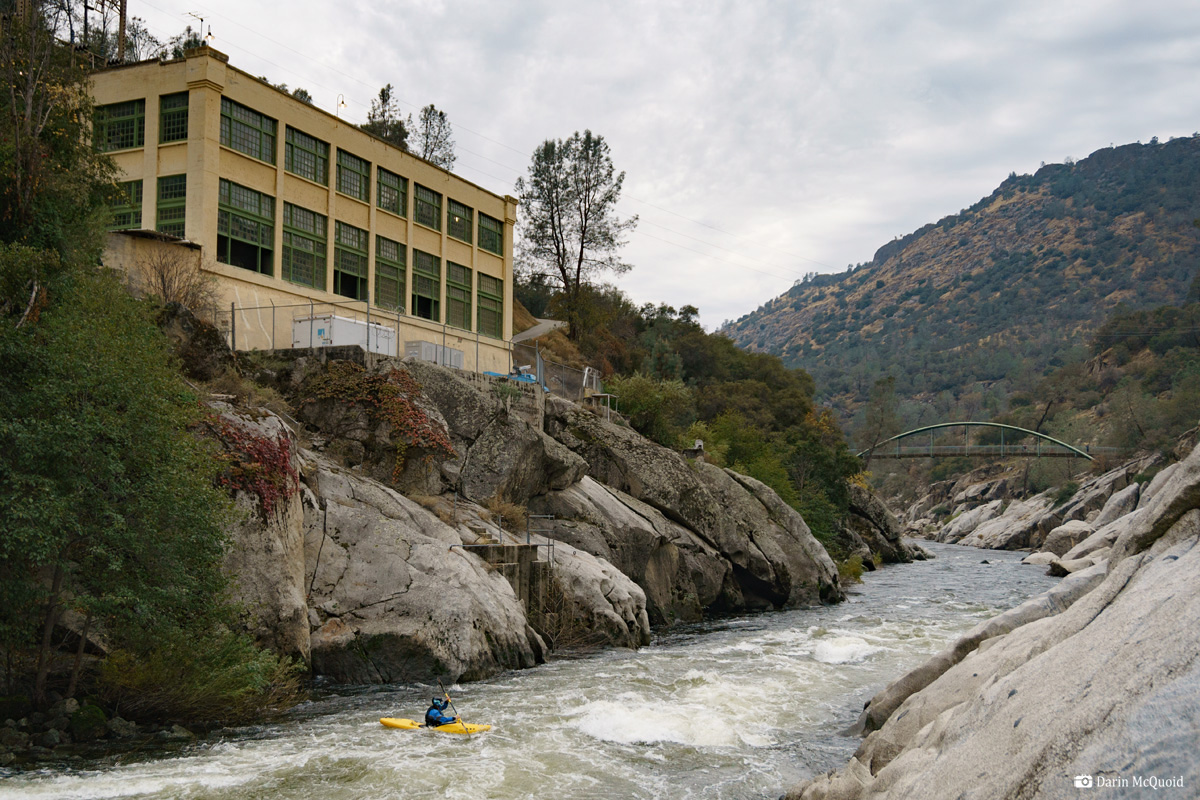
Over the last decade a nice trail system has been developed, part of which is this beautiful footbridge which crosses the San Joaquin just downstream of the Kerckhoff #1.
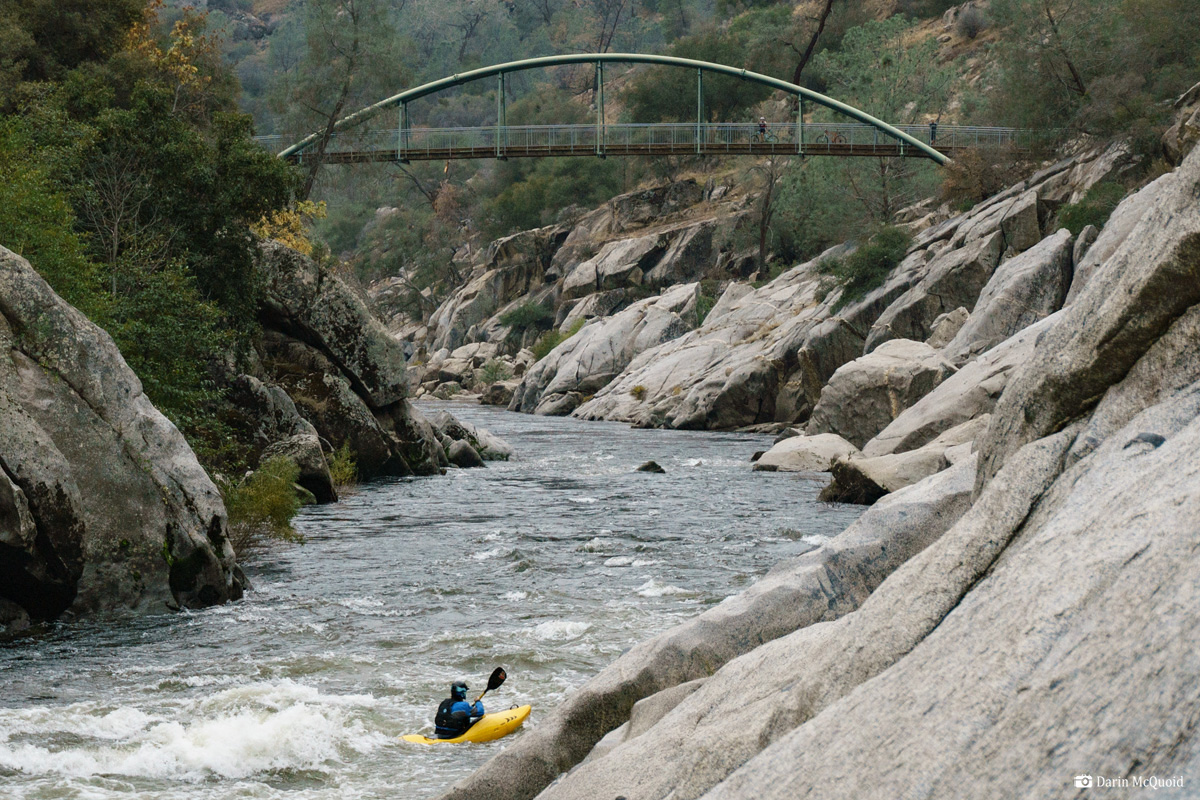
Jeff Wheeler enters Upper Squaw Leap.
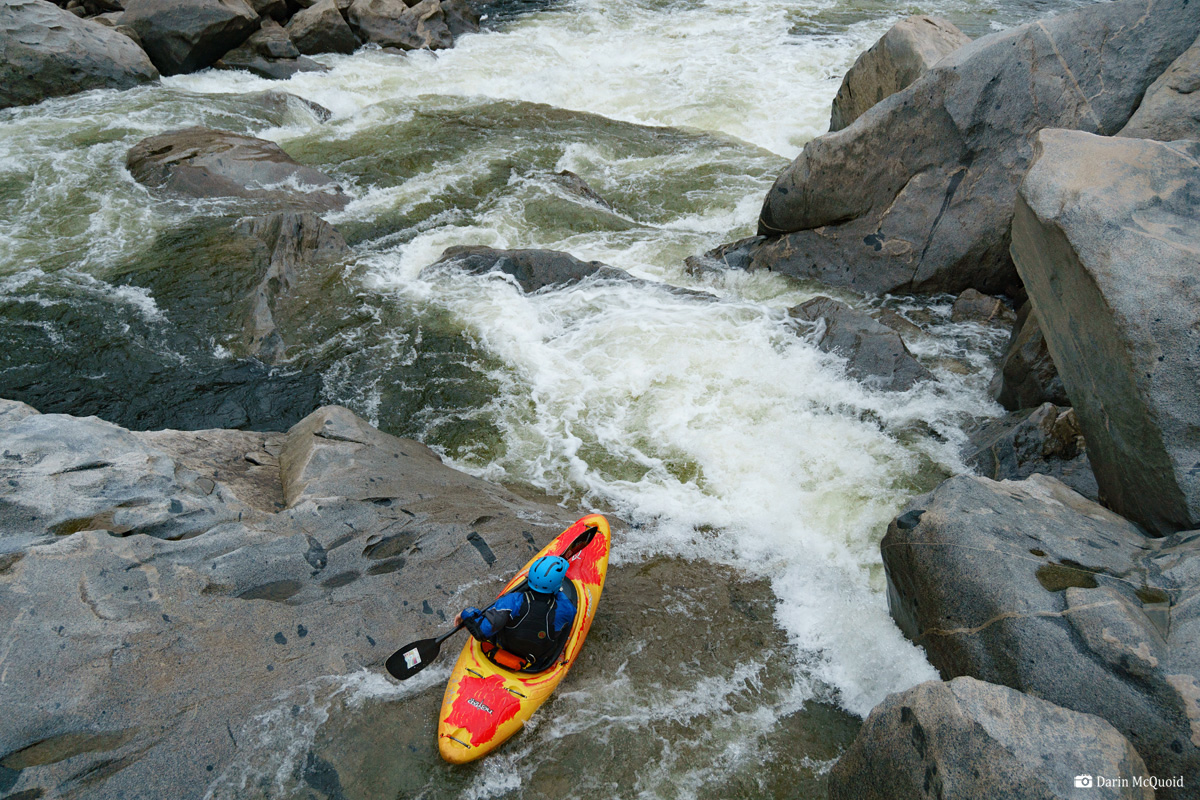
Jeff Wheeler punches a river wide hole at the bottom of Upper Squaw Leap.
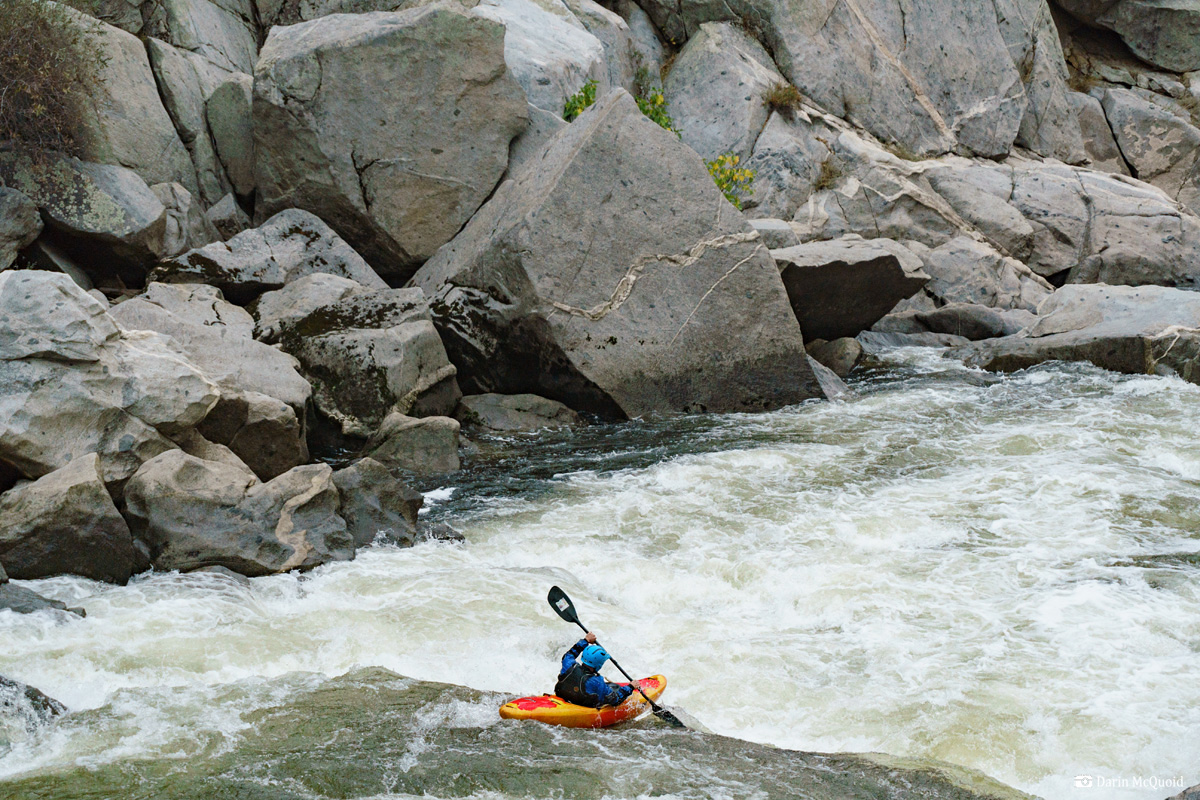
At
flows around 2,000cfs there is a nice recovery pool between Upper Squaw
Leap and Lower Squaw Leap, as well as a good spot to get out on river
right at Lower Squaw Leap. When flows peaked to 3,000 it wasn't so easy
to get out on river right, although the higher flow actually makes the
rapid easier than at lower flows because the bottom hole washes out.
Daniel Brasuell at the top of Squaw Leap.
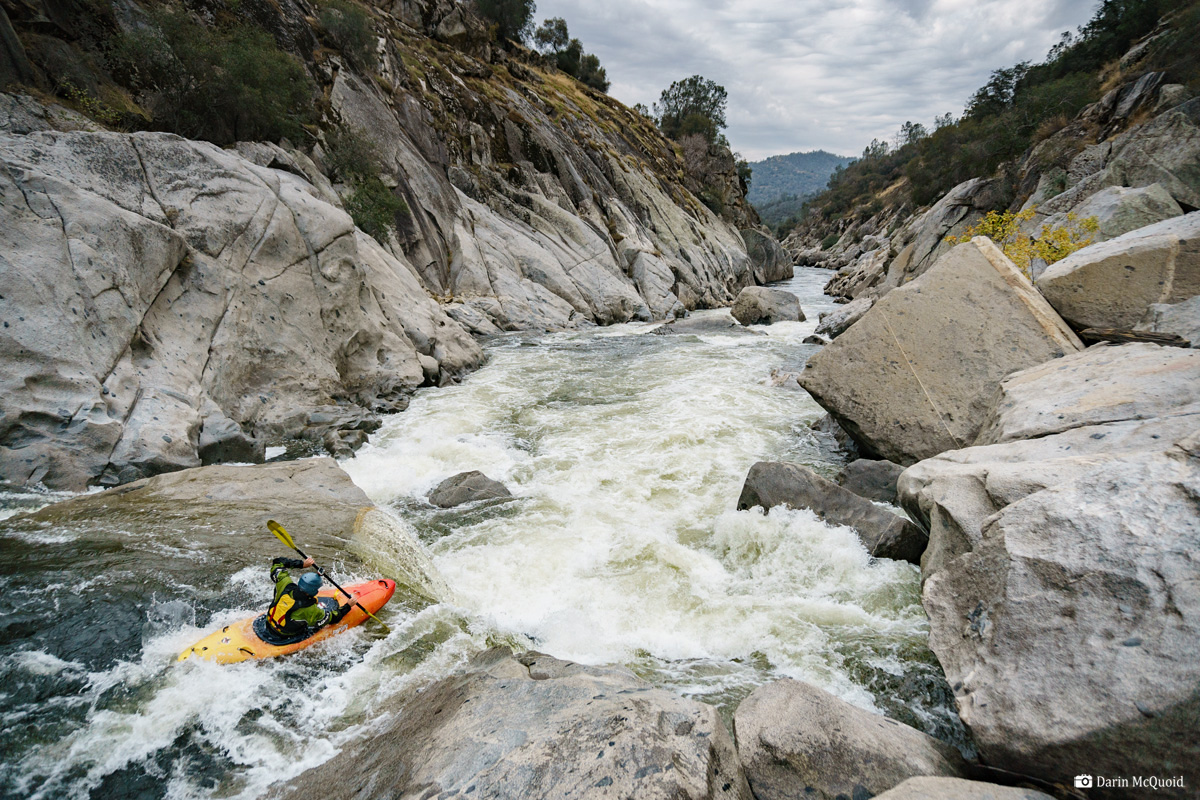
We looked at a variety of lines, I thought the center boof would rob too much speed, but Jeff Wheeler proves me wrong with a nice line.
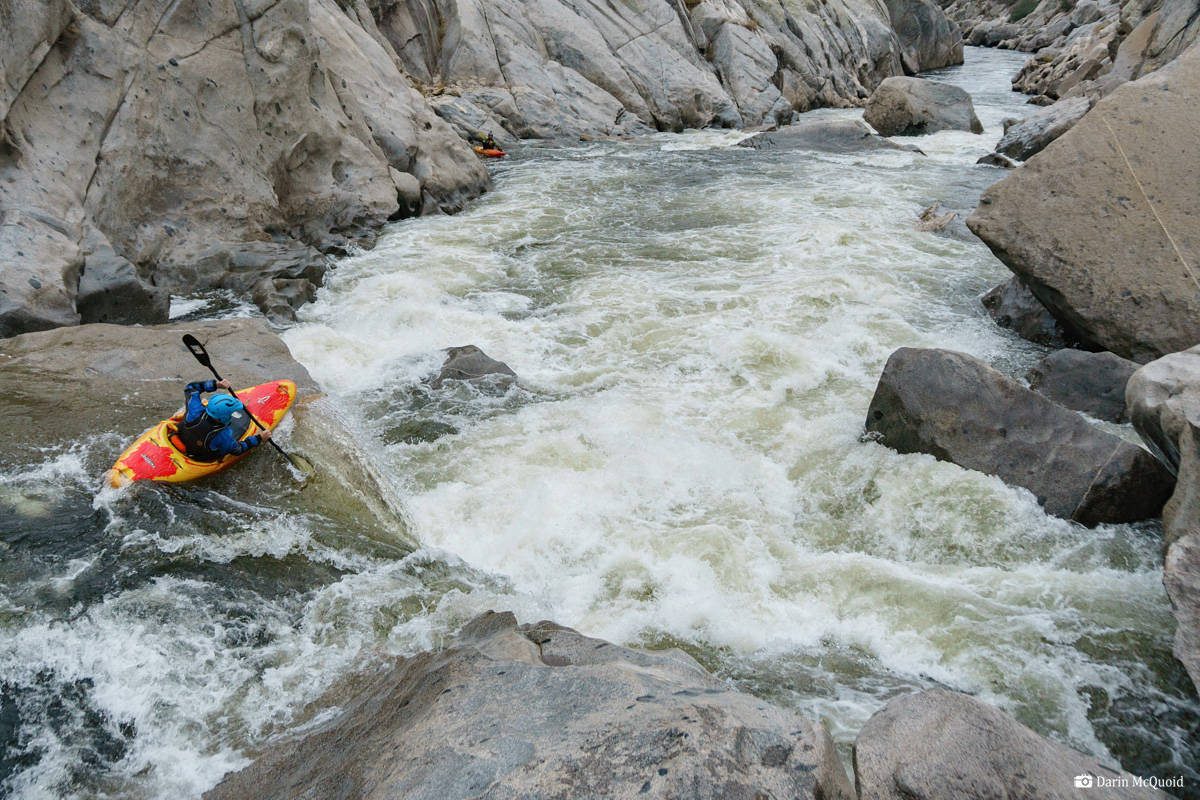
Getting left is key in the second half of Squaw Leap. The right channel is not very nice, on top of all the chunky rock, a good portion of water goes into a siphon out of view on the far right...below the siphon that is visible. Classic San Joaquin.
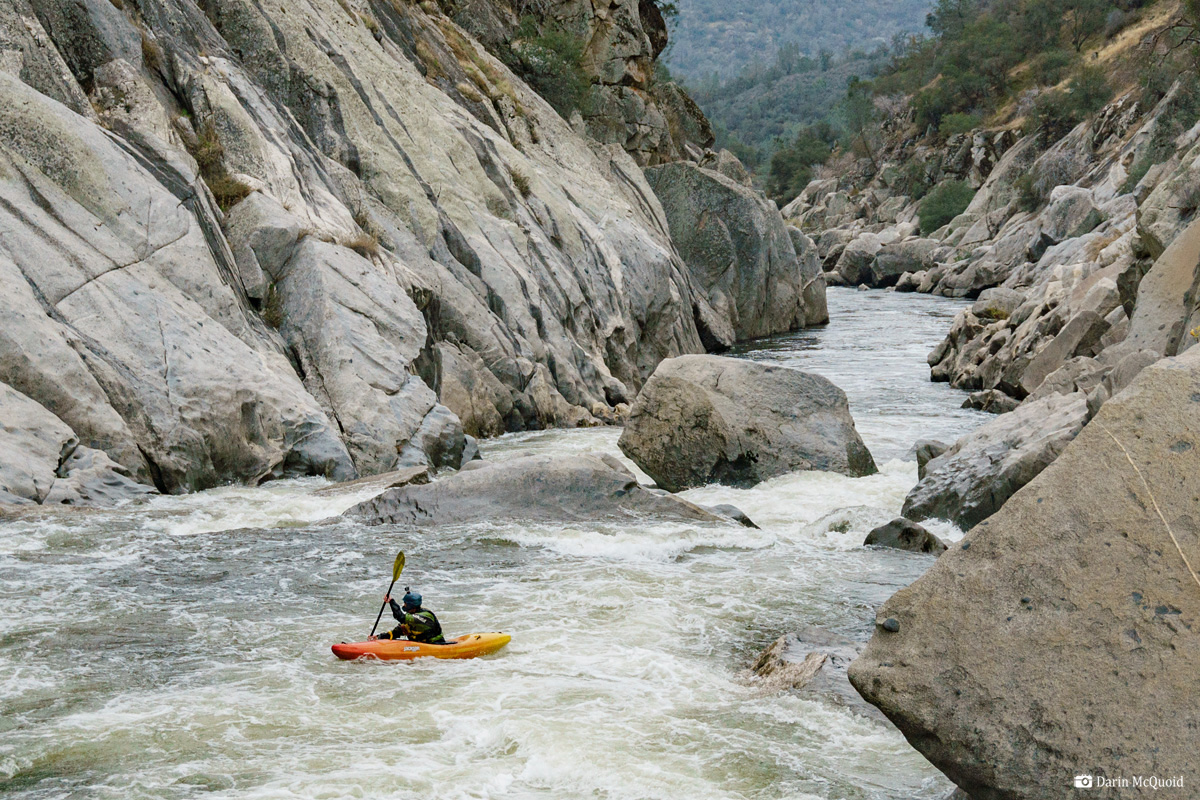
The hike up felt a bit longer than we expected, but probably only took about 15 minutes.
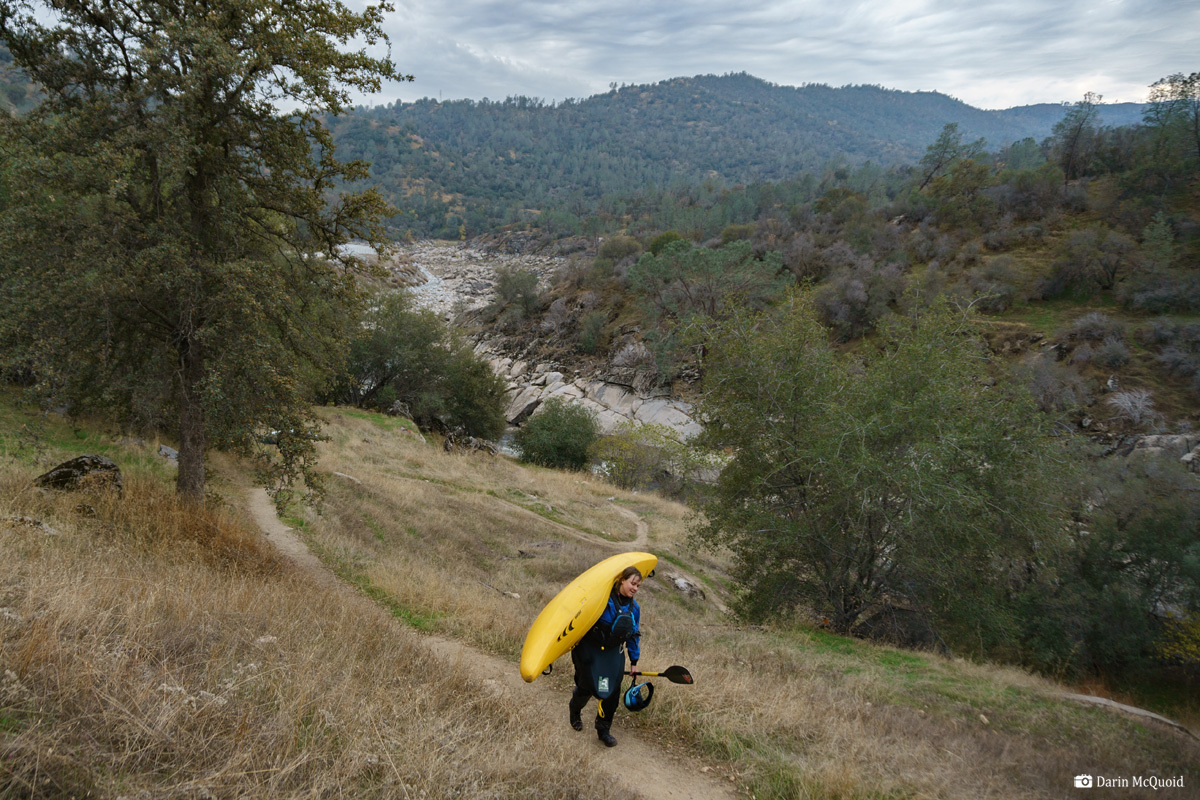
Some great fall weather and cloud formations.
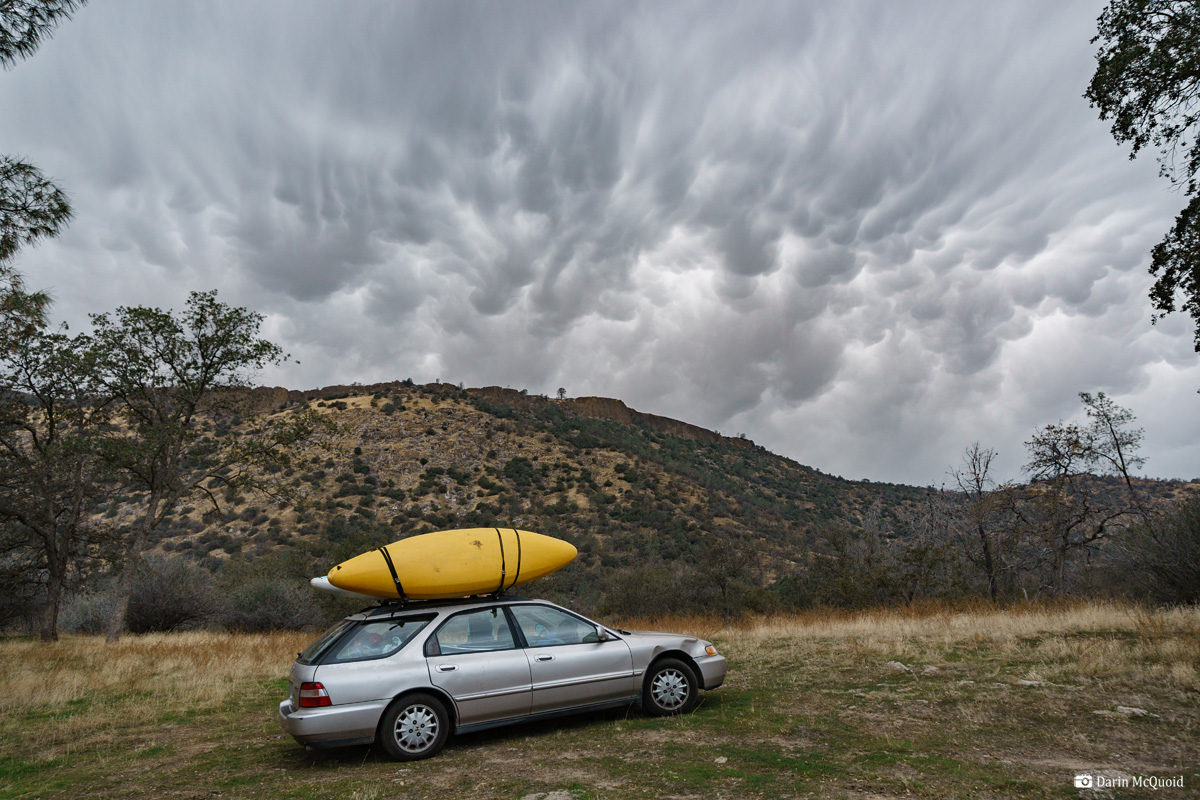
Put In and Take out Via Google Maps.

San Joaquin at Patterson Bend Gauge. We had 2,000 for most of the photographs.